tow BMW M5 2014 F10M Owner's Guide
[x] Cancel search | Manufacturer: BMW, Model Year: 2014, Model line: M5, Model: BMW M5 2014 F10MPages: 237, PDF Size: 5.21 MB
Page 192 of 237
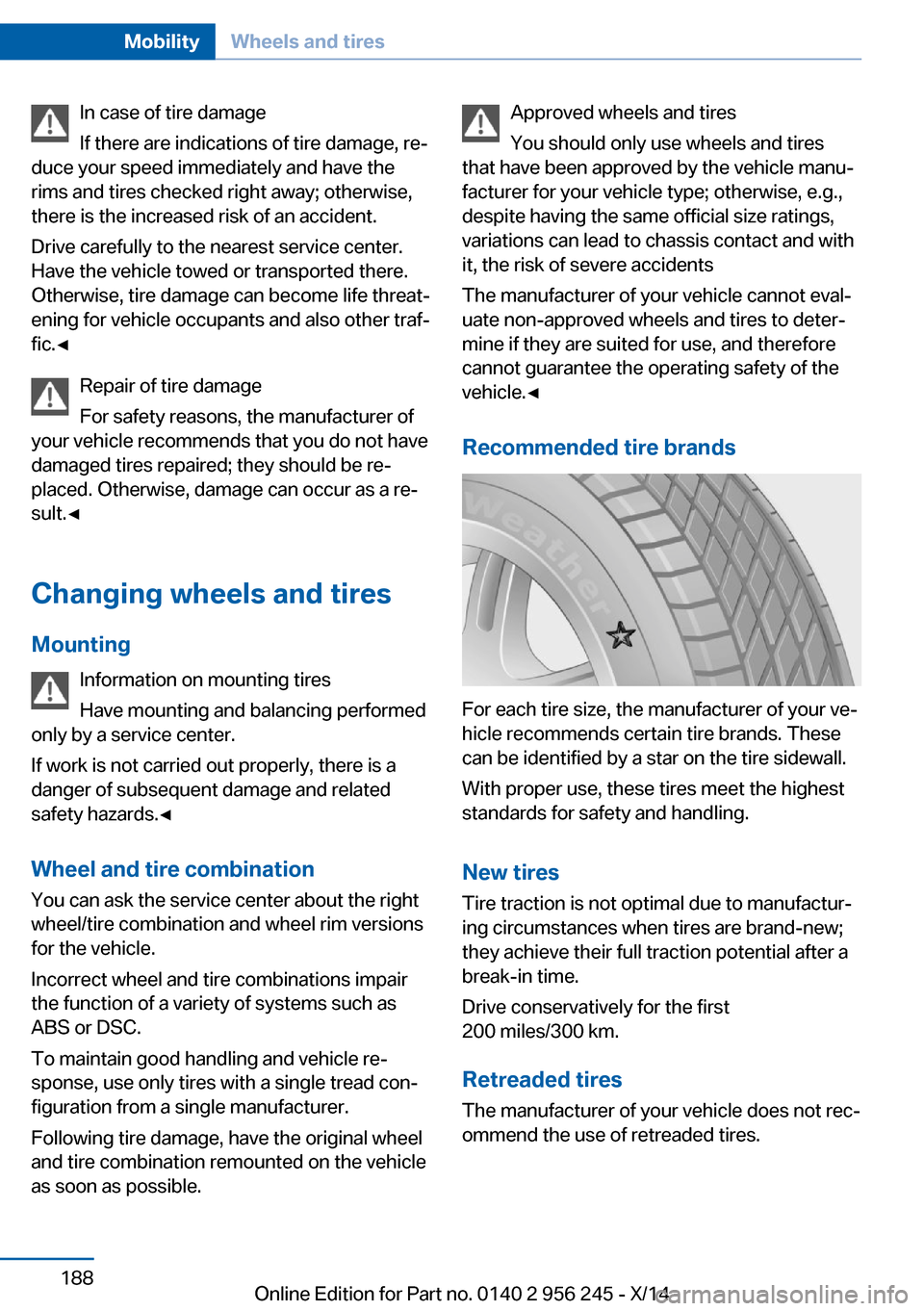
In case of tire damage
If there are indications of tire damage, re‐
duce your speed immediately and have the
rims and tires checked right away; otherwise,
there is the increased risk of an accident.
Drive carefully to the nearest service center.
Have the vehicle towed or transported there.
Otherwise, tire damage can become life threat‐
ening for vehicle occupants and also other traf‐
fic.◀
Repair of tire damage
For safety reasons, the manufacturer of
your vehicle recommends that you do not have
damaged tires repaired; they should be re‐
placed. Otherwise, damage can occur as a re‐
sult.◀
Changing wheels and tires
Mounting Information on mounting tires
Have mounting and balancing performed
only by a service center.
If work is not carried out properly, there is a
danger of subsequent damage and related
safety hazards.◀
Wheel and tire combination
You can ask the service center about the right
wheel/tire combination and wheel rim versions
for the vehicle.
Incorrect wheel and tire combinations impair
the function of a variety of systems such as
ABS or DSC.
To maintain good handling and vehicle re‐
sponse, use only tires with a single tread con‐
figuration from a single manufacturer.
Following tire damage, have the original wheel
and tire combination remounted on the vehicle
as soon as possible.Approved wheels and tires
You should only use wheels and tires
that have been approved by the vehicle manu‐
facturer for your vehicle type; otherwise, e.g.,
despite having the same official size ratings,
variations can lead to chassis contact and with
it, the risk of severe accidents
The manufacturer of your vehicle cannot eval‐
uate non-approved wheels and tires to deter‐
mine if they are suited for use, and therefore
cannot guarantee the operating safety of the
vehicle.◀
Recommended tire brands
For each tire size, the manufacturer of your ve‐
hicle recommends certain tire brands. These
can be identified by a star on the tire sidewall.
With proper use, these tires meet the highest
standards for safety and handling.
New tires Tire traction is not optimal due to manufactur‐
ing circumstances when tires are brand-new;
they achieve their full traction potential after a
break-in time.
Drive conservatively for the first
200 miles/300 km.
Retreaded tires
The manufacturer of your vehicle does not rec‐
ommend the use of retreaded tires.
Seite 188MobilityWheels and tires188
Online Edition for Part no. 0140 2 956 245 - X/14
Page 195 of 237

4.Insert the sealant container on the com‐
pressor housing in an upright position.5.Screw the filling hose of the sealant con‐
tainer onto the tire valve of the defective
wheel.6.With the compressor switched off, insert
the plug into the power socket inside the
vehicle.7.With the ignition turned on or the engine
running, reel on the compressor.
Switch off the compressor after 10 mi‐
nutes
Do not allow the compressor to run longer than
10 minutes; otherwise, the device will overheat
and may be damaged.◀
Let the compressor run for approx. 3 to 8 mi‐
nutes to fill the tire with sealant and achieve a
tire inflation pressure of approx. 2.5 bar.
While the tire is being filled with sealant, the
tire inflation pressure may sporadically reach
approx. 5 bar. Do not reel off the compressor at
this point.
If a tire inflation pressure of 2 bar is not
reached:
1.Switch off the compressor.2.Unscrew the filling hose from the wheel.3.Drive 33 ft/10 m forward and back to dis‐
tribute the sealant in the tire.4.Inflate the tire again using the compressor.
If a tire inflation pressure of 2 bar cannot be
reached, contact your service center.
Stowing the Mobility System
1.Unscrew the filling hose of the sealant con‐
tainer from the wheel.2.Unscrew the connection hose of the com‐
pressor from the sealant container.3.Connect the filling hose of the sealant con‐
tainer previously connected to the tire
valve with the available connector on the
sealant container.Seite 191Wheels and tiresMobility191
Online Edition for Part no. 0140 2 956 245 - X/14
Page 196 of 237

This prevents leftover sealant from escap‐
ing from the container.4.Wrap the empty sealant container in suita‐
ble material to avoid dirtying the cargo
area.5.Stow the Mobility System back in the vehi‐
cle.
Distributing the sealant
Immediately drive approx. 5 miles/10 km to en‐
sure that the sealant is evenly distributed in the
tire.
Do not exceed a speed of 50 mph/80 km/h.
If possible, do not drive at speeds less than
12 mph/20 km/h.
To correct the tire inflation pressure
1.Stop at a suitable location.2.Screw the connection hose of the com‐
pressor directly onto the tire valve stem.3.Insert the connector into the power socket
inside the vehicle.4.Correct the tire inflation pressure to
2.5 bar.▷Increase pressure: with the ignition
turned on or the engine running, reel
on the compressor.▷To reduce the pressure: press the but‐
ton on the compressor.
Continuing the trip
Do not exceed the maximum permissible
speed of 50 mph/80 km/h.
Reinitialize the Flat Tire Monitor.
Reinitialize the Tire Pressure Monitor.
Replace the defective tire and the sealant con‐
tainer of the Mobility System as soon as possi‐
ble.
Snow chains
Fine-link snow chains Only certain types of fine-link snow chains
have been tested by the manufacturer of the
vehicle, classified as road-safe and approved.
Information about the approved snow chains
are available from the service center.
Use Use only in pairs on the rear wheels, equipped
with the tires of the following size:▷255/40 R 19▷255/35 R 20
Follow the snow chain manufacturer's instruc‐
tions.
Make sure that the snow chains are always
sufficiently tight. Retighten as needed accord‐
ing to the chain manufacturer's instructions.
Do not initialize the Flat Tire Monitor after
mounting snow chains, as doing so may result
in incorrect readings.
Do not initialize the Tire Pressure Monitor after
mounting snow chains, as doing so may result
in incorrect readings.
When driving with snow chains, if needed
briefly activate M Dynamic Mode.
Maximum speed with snow chains
Do not exceed a speed of 30 mph/50 km/h
when using snow chains.
Seite 192MobilityWheels and tires192
Online Edition for Part no. 0140 2 956 245 - X/14
Page 205 of 237
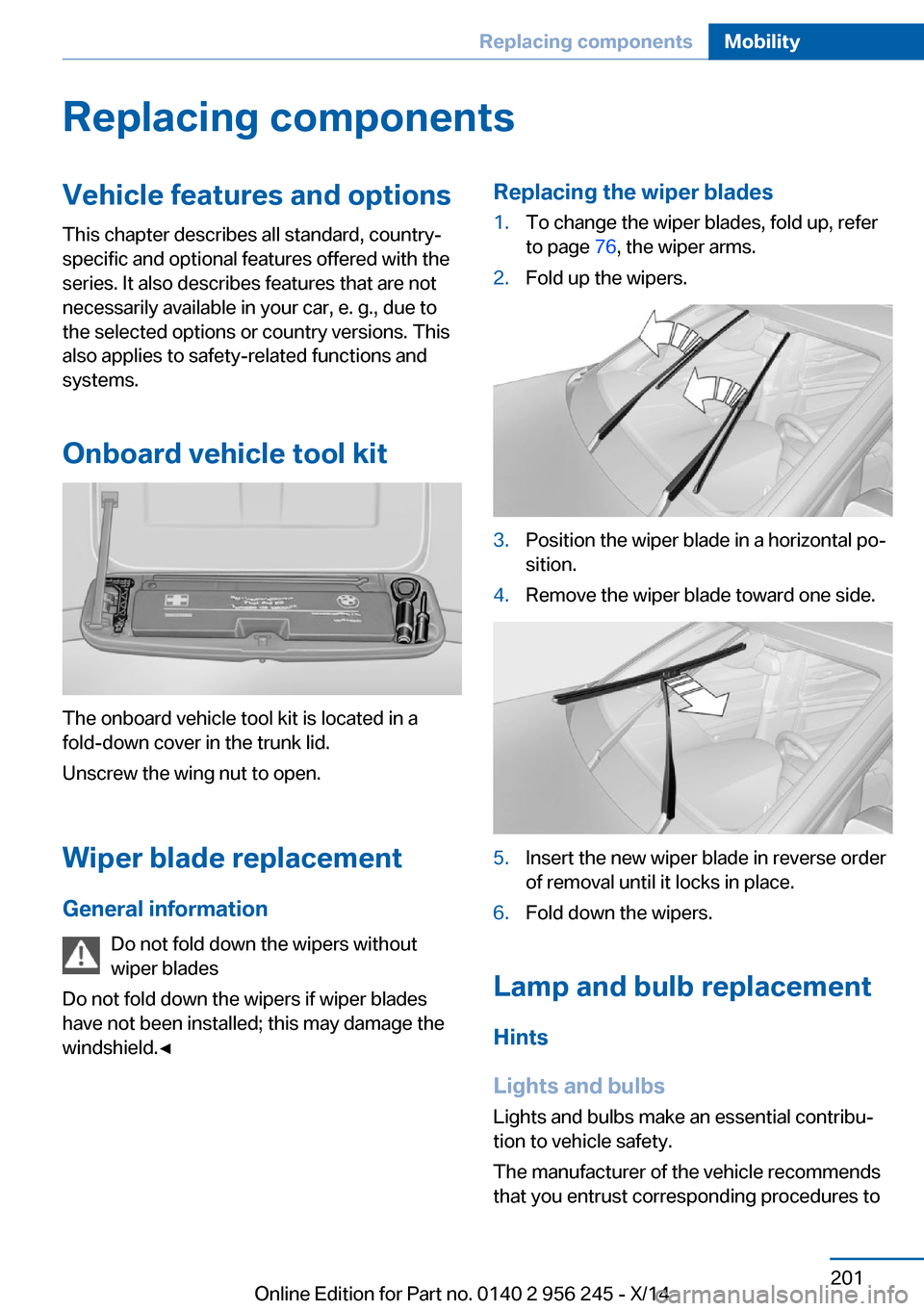
Replacing componentsVehicle features and optionsThis chapter describes all standard, country-
specific and optional features offered with the
series. It also describes features that are not
necessarily available in your car, e. g., due to
the selected options or country versions. This
also applies to safety-related functions and
systems.
Onboard vehicle tool kit
The onboard vehicle tool kit is located in a
fold-down cover in the trunk lid.
Unscrew the wing nut to open.
Wiper blade replacement
General information Do not fold down the wipers without
wiper blades
Do not fold down the wipers if wiper blades
have not been installed; this may damage the
windshield.◀
Replacing the wiper blades1.To change the wiper blades, fold up, refer
to page 76, the wiper arms.2.Fold up the wipers.3.Position the wiper blade in a horizontal po‐
sition.4.Remove the wiper blade toward one side.5.Insert the new wiper blade in reverse order
of removal until it locks in place.6.Fold down the wipers.
Lamp and bulb replacement
Hints
Lights and bulbs
Lights and bulbs make an essential contribu‐
tion to vehicle safety.
The manufacturer of the vehicle recommends
that you entrust corresponding procedures to
Seite 201Replacing componentsMobility201
Online Edition for Part no. 0140 2 956 245 - X/14
Page 215 of 237
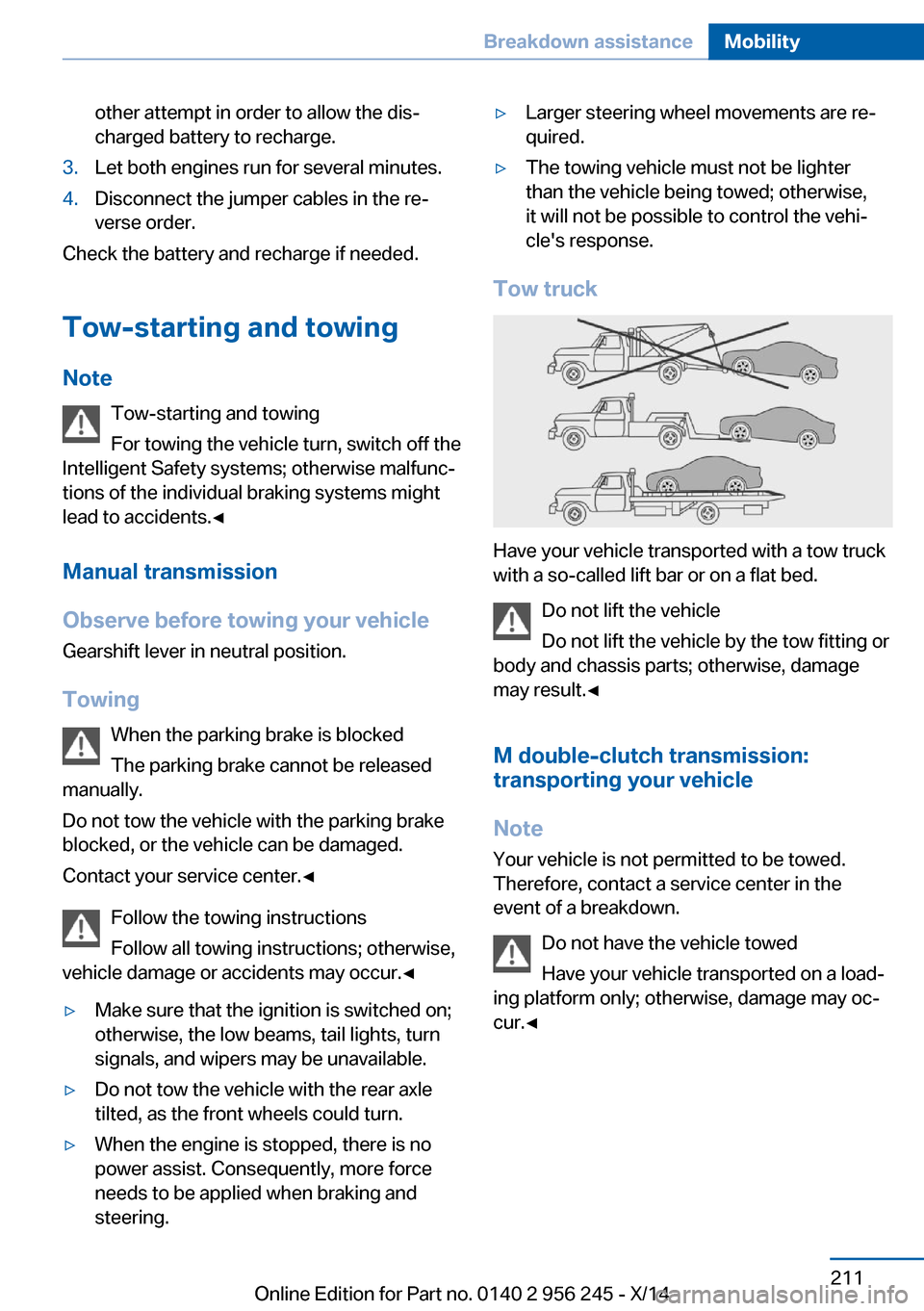
other attempt in order to allow the dis‐
charged battery to recharge.3.Let both engines run for several minutes.4.Disconnect the jumper cables in the re‐
verse order.
Check the battery and recharge if needed.
Tow-starting and towing Note Tow-starting and towing
For towing the vehicle turn, switch off the
Intelligent Safety systems; otherwise malfunc‐
tions of the individual braking systems might
lead to accidents.◀
Manual transmission
Observe before towing your vehicle Gearshift lever in neutral position.
Towing When the parking brake is blocked
The parking brake cannot be released
manually.
Do not tow the vehicle with the parking brake
blocked, or the vehicle can be damaged.
Contact your service center.◀
Follow the towing instructions
Follow all towing instructions; otherwise,
vehicle damage or accidents may occur.◀
▷Make sure that the ignition is switched on;
otherwise, the low beams, tail lights, turn
signals, and wipers may be unavailable.▷Do not tow the vehicle with the rear axle
tilted, as the front wheels could turn.▷When the engine is stopped, there is no
power assist. Consequently, more force
needs to be applied when braking and
steering.▷Larger steering wheel movements are re‐
quired.▷The towing vehicle must not be lighter
than the vehicle being towed; otherwise,
it will not be possible to control the vehi‐
cle's response.
Tow truck
Have your vehicle transported with a tow truck
with a so-called lift bar or on a flat bed.
Do not lift the vehicle
Do not lift the vehicle by the tow fitting or
body and chassis parts; otherwise, damage
may result.◀
M double-clutch transmission:
transporting your vehicle
Note Your vehicle is not permitted to be towed.
Therefore, contact a service center in the
event of a breakdown.
Do not have the vehicle towed
Have your vehicle transported on a load‐
ing platform only; otherwise, damage may oc‐
cur.◀
Seite 211Breakdown assistanceMobility211
Online Edition for Part no. 0140 2 956 245 - X/14
Page 216 of 237

Tow truck
Do not lift the vehicle
Do not lift the vehicle by the tow fitting or
body and chassis parts; otherwise, damage
may result.◀
Use tow fitting located in the front only for po‐
sitioning the vehicle.
Towing other vehicles
Hints Light towing vehicle
The towing vehicle must not be lighter
than the vehicle being towed; otherwise, it will
not be possible to control the vehicle's re‐
sponse.◀
Attaching the tow bar/tow rope correctly
Attach the tow bar or tow rope to the tow
fitting; connecting it to other vehicle parts may
cause damage.◀
▷Switch on the hazard warning system, de‐
pending on local regulations.▷If the electrical system has failed, clearly
identify the vehicle being towed by placing
a sign or a warning triangle in the rear win‐
dow.
Tow bar
The tow fittings used should be on the same
side on both vehicles.
Should it prove impossible to avoid mounting
the tow bar at an offset angle, please observe
the following:▷Maneuvering capability is limited going
around corners.▷The tow bar will generate lateral forces if it
is secured with an offset.
Tow rope
When starting to tow the vehicle, make sure
that the tow rope is taut.
To avoid jerking and the associated stresses
on the vehicle components when towing, al‐
ways use nylon ropes or nylon straps.
Tow fitting
The screw-in tow fitting should always be car‐
ried in the vehicle.
The tow fitting can be screwed in at the front
or rear of the BMW.
The tow fitting is located in the container on
the inside of the trunk lid.
Tow fitting, information on use
▷Use only the tow fitting provided with
the vehicle and screw it all the way in.▷Use the tow fitting for towing on paved
roads only.▷Avoid lateral loading of the tow fitting, e.g.,
do not lift the vehicle by the tow fitting.
Otherwise, damage to the tow fitting and the
vehicle can occur.◀
Seite 212MobilityBreakdown assistance212
Online Edition for Part no. 0140 2 956 245 - X/14
Page 217 of 237
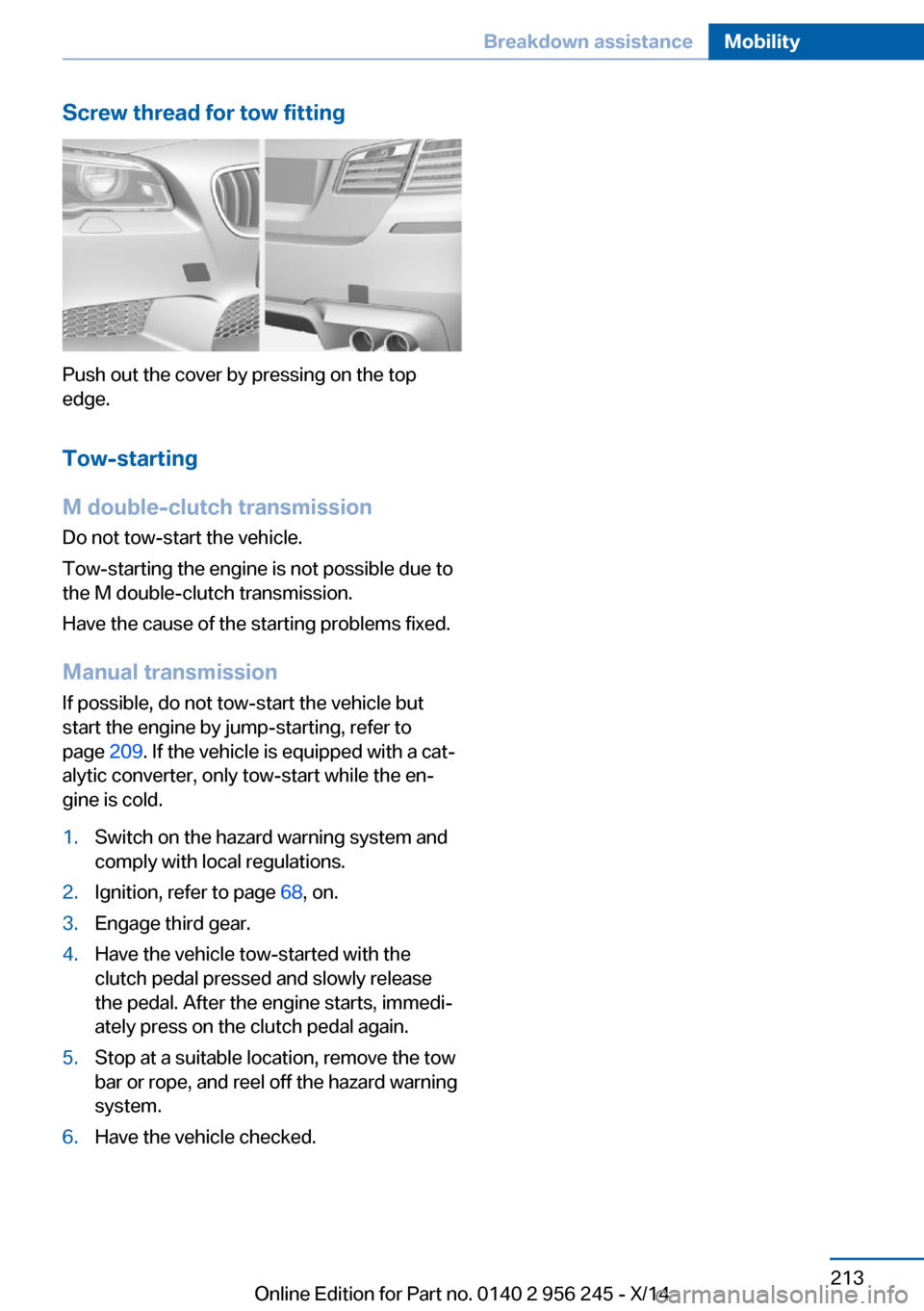
Screw thread for tow fitting
Push out the cover by pressing on the top
edge.
Tow-starting
M double-clutch transmission
Do not tow-start the vehicle.
Tow-starting the engine is not possible due to
the M double-clutch transmission.
Have the cause of the starting problems fixed.
Manual transmission
If possible, do not tow-start the vehicle but
start the engine by jump-starting, refer to
page 209. If the vehicle is equipped with a cat‐
alytic converter, only tow-start while the en‐
gine is cold.
1.Switch on the hazard warning system and
comply with local regulations.2.Ignition, refer to page 68, on.3.Engage third gear.4.Have the vehicle tow-started with the
clutch pedal pressed and slowly release
the pedal. After the engine starts, immedi‐
ately press on the clutch pedal again.5.Stop at a suitable location, remove the tow
bar or rope, and reel off the hazard warning
system.6.Have the vehicle checked.Seite 213Breakdown assistanceMobility213
Online Edition for Part no. 0140 2 956 245 - X/14
Page 226 of 237
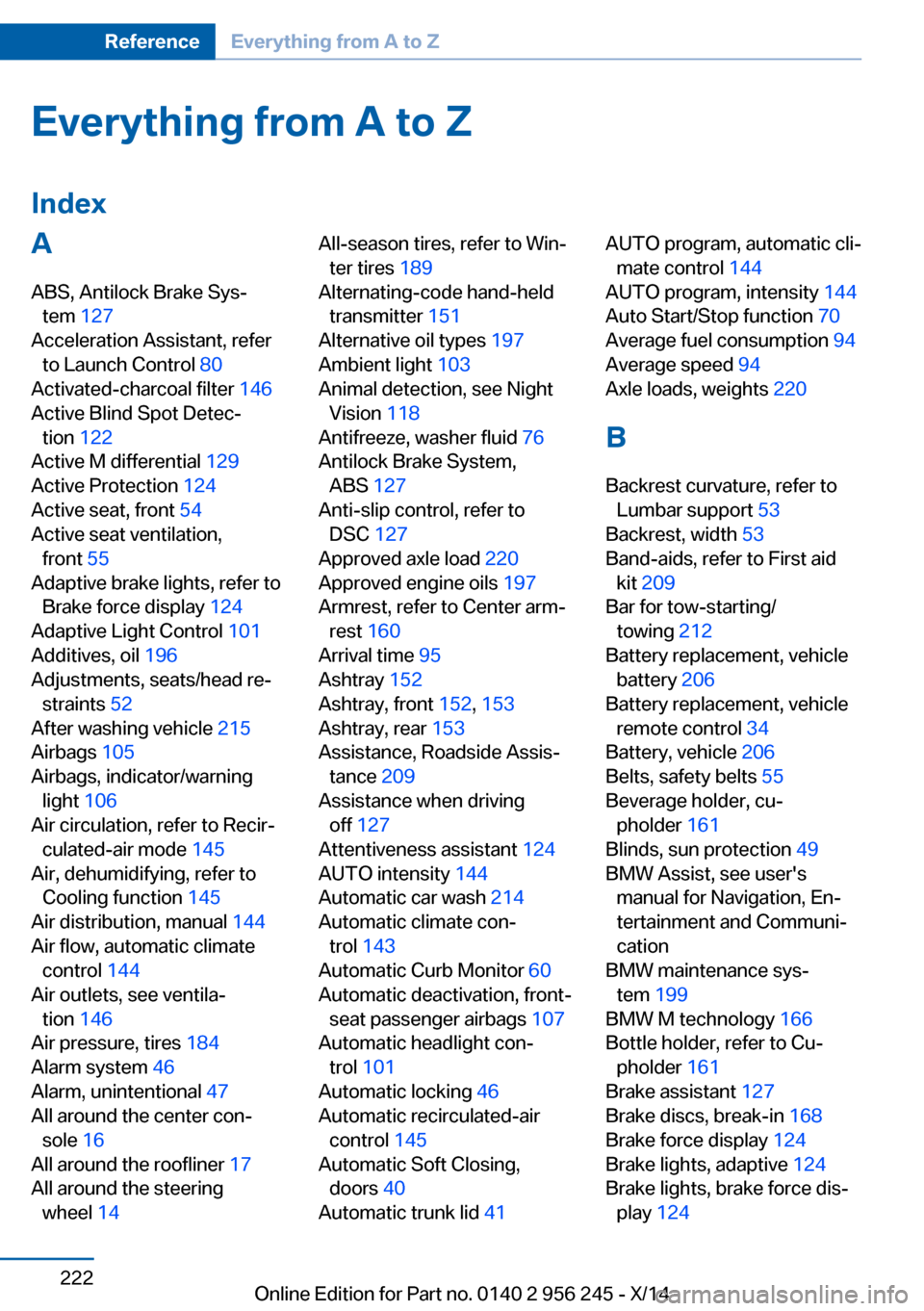
Everything from A to Z
IndexA ABS, Antilock Brake Sys‐ tem 127
Acceleration Assistant, refer to Launch Control 80
Activated-charcoal filter 146
Active Blind Spot Detec‐ tion 122
Active M differential 129
Active Protection 124
Active seat, front 54
Active seat ventilation, front 55
Adaptive brake lights, refer to Brake force display 124
Adaptive Light Control 101
Additives, oil 196
Adjustments, seats/head re‐ straints 52
After washing vehicle 215
Airbags 105
Airbags, indicator/warning light 106
Air circulation, refer to Recir‐ culated-air mode 145
Air, dehumidifying, refer to Cooling function 145
Air distribution, manual 144
Air flow, automatic climate control 144
Air outlets, see ventila‐ tion 146
Air pressure, tires 184
Alarm system 46
Alarm, unintentional 47
All around the center con‐ sole 16
All around the roofliner 17
All around the steering wheel 14 All-season tires, refer to Win‐
ter tires 189
Alternating-code hand-held transmitter 151
Alternative oil types 197
Ambient light 103
Animal detection, see Night Vision 118
Antifreeze, washer fluid 76
Antilock Brake System, ABS 127
Anti-slip control, refer to DSC 127
Approved axle load 220
Approved engine oils 197
Armrest, refer to Center arm‐ rest 160
Arrival time 95
Ashtray 152
Ashtray, front 152, 153
Ashtray, rear 153
Assistance, Roadside Assis‐ tance 209
Assistance when driving off 127
Attentiveness assistant 124
AUTO intensity 144
Automatic car wash 214
Automatic climate con‐ trol 143
Automatic Curb Monitor 60
Automatic deactivation, front- seat passenger airbags 107
Automatic headlight con‐ trol 101
Automatic locking 46
Automatic recirculated-air control 145
Automatic Soft Closing, doors 40
Automatic trunk lid 41 AUTO program, automatic cli‐
mate control 144
AUTO program, intensity 144
Auto Start/Stop function 70
Average fuel consumption 94
Average speed 94
Axle loads, weights 220
B Backrest curvature, refer to Lumbar support 53
Backrest, width 53
Band-aids, refer to First aid kit 209
Bar for tow-starting/ towing 212
Battery replacement, vehicle battery 206
Battery replacement, vehicle remote control 34
Battery, vehicle 206
Belts, safety belts 55
Beverage holder, cu‐ pholder 161
Blinds, sun protection 49
BMW Assist, see user's manual for Navigation, En‐
tertainment and Communi‐
cation
BMW maintenance sys‐ tem 199
BMW M technology 166
Bottle holder, refer to Cu‐ pholder 161
Brake assistant 127
Brake discs, break-in 168
Brake force display 124
Brake lights, adaptive 124
Brake lights, brake force dis‐ play 124 Seite 222ReferenceEverything from A to Z222
Online Edition for Part no. 0140 2 956 245 - X/14
Page 229 of 237

Exterior mirror, automaticdimming feature 60
Exterior mirrors 59
External start 209
External temperature dis‐ play 88
External temperature warn‐ ing 88
Eyes for securing cargo 173
F
Failure message, see Check Control 84
False alarm, refer to Uninten‐ tional alarm 47
Fan, refer to Air flow 144
Filler neck for engine oil 196
Fine wood, care 216
First aid kit 209
Fitting for towing, see tow fit‐ ting 212
Flat tire, changing wheels 205
Flat Tire Monitor FTM 111
Flat tire, Tire Pressure Moni‐ tor TPM 108
Flat tire, warning lamp 109, 111
Flooding 170
Floor carpet, care 217
Floor mats, care 217
Fold down the rear seat back‐ rest, see Though-loading
system 155
Fold-out position, wiper 76
Foot brake 170
Front airbags 105
Front-end collision warning with City Braking func‐
tion 113
Front lights 202
front-seat passenger airbags, automatic deactivation 107
Front-seat passenger airbags, indicator lamp 107 FTM Flat Tire Monitor 111
Fuel 182
Fuel consumption, current 89
Fuel consumption, refer to Average fuel consump‐
tion 94
Fuel filler flap 180
Fuel gauge 87
Fuel lid 180
Fuel quality 182
Fuel recommendation 182
Fuel, tank capacity 221
Fuse 207
G
Garage door opener, refer to Universal Integrated Remote
Control 150
Gasoline 182
Gear change 79
Gear shift indicator 92
General driving notes 169
Glare shield 152
Glass sunroof, powered 49
Glove compartment 159
Gross vehicle weight, ap‐ proved 220
Ground clearance 171
H
Handbrake, refer to Parking brake 72
Hand-held transmitter, alter‐ nating code 151
Hazard warning flashers 208
Head airbags 105
Headlight control, auto‐ matic 101
Headlight courtesy delay fea‐ ture 100
Headlight courtesy delay fea‐ ture via remote control 38
Headlight flasher 74
Headlight glass 202 Headlights 202
Headlights, care 215
Headlight washer system 74
Head restraints 52
Head restraints, front 56
Head restraints, rear 57
Head-up Display 97
Head-up Display, care 217
Head-up display, M view 98
Head-up display, standard view 98
Heavy cargo, stowing 173
Height, vehicle 220
High-beam Assistant 102
High beams 74
High beams/low beams, refer to High-beam Assistant 102
Higher speed range 171
Hills 170
Hill start assistant, refer to Drive-off assistant 127
Hints 6
Holder for beverages 161
Hood 193
Horn 14
Hotel function, trunk lid 42
Hot exhaust system 169
HUD Head-up Display 97
Hydroplaning 169
I Ice warning, see External temperature warning 88
Icy roads, see External tem‐ perature warning 88
Identification marks, tires 185
Identification number, see ve‐ hicle identification num‐
ber 9
iDrive 18
Ignition key, refer to Remote control 34
Ignition off 68
Ignition on 68 Seite 225Everything from A to ZReference225
Online Edition for Part no. 0140 2 956 245 - X/14
Page 231 of 237

Manual operation, doorlock 39
Manual operation, exterior mirrors 60
Manual operation, fuel filler flap 180
Manual operation, Park Dis‐ tance Control PDC 135
Manual operation, rearview camera 137
Manual operation, Side View 140
Manual operation, Top View 141
Manual transmission 82
Marking on approved tires 188
Massage seat, front 54
Master key, refer to Remote control 34
Maximum cooling 145
Maximum speed, display 92
Maximum speed, winter tires 189
M carbon ceramic brake 166
M Compound brake 166
M differential, active 129
MDM, M Dynamic Mode 128
M double-clutch transmis‐ sion 77
M Drive 62
M Driver's Package, driving instructions 171
M Driving Dynamics Con‐ trol 81
M Dynamic Mode MDM 128
Measure, units of 97
Medical kit 209
Memory for seat, mirrors, steering wheel 58
Menu in instrument clus‐ ter 93
Menus, operating, iDrive 18
Menus, refer to iDrive operat‐ ing concept 19 Messages, see Check Con‐
trol 84
Microfilter 146
Minimum tread, tires 187
Mirror 59
Mirror memory 58
Mobile communication devi‐ ces in the vehicle 169
Mobility System 189
Modifications, technical, refer to Safety 7
Moisture in headlight 202
Monitor, refer to Control Dis‐ play 18
Mounting of child restraint systems 64
M technology 166
Multifunction steering wheel, buttons 14
M view, head-up display 98
N Navigation, see user's manual for Navigation, Entertain‐
ment and Communication
Neck restraints, front, refer to Head restraints 56
Neck restraints, rear, refer to Head restraints 57
Neutral cleaner, see wheel cleaner 216
New wheels and tires 188
Night Vision 118
Night Vision device, see Night Vision 118
Nylon rope for tow-starting/ towing 212
O OBD Onboard Diagnosis 199
OBD, see OBD Onboard Di‐ agnosis 199
Object detection, see Night Vision 118 Obstacle marking, rearview
camera 138
Octane rating, refer to Rec‐ ommended fuel grade 182
Odometer 88
Office, see user's manual for Navigation, Entertainment
and Communication
Oil 195
Oil, adding 196
Oil additives 196
Oil change 197
Oil change interval, service requirements 91
Oil filler neck 196
Oil types, alternative 197
Oil types, approved 197
Old batteries, disposal 206
Onboard monitor, refer to Control Display 18
Onboard vehicle tool kit 201
Opening/closing via door lock 39
Opening and closing 34
Opening and closing, without remote control 39
Opening and closing, with re‐ mote control 37
Opening the trunk lid with no- touch activation 44
Operating concept, iDrive 18
Optional equipment, standard equipment 6
Outside air, refer to Auto‐ matic recirculated-air con‐
trol 145
Overheating of engine, refer to Coolant temperature 88
P Paint, vehicle 215
Park Distance Control PDC 134
Parked-car ventilation 149 Seite 227Everything from A to ZReference227
Online Edition for Part no. 0140 2 956 245 - X/14